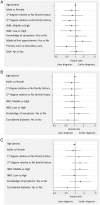The pathway to diagnosis of type 1 diabetes in children: a questionnaire study - PubMed (original) (raw)
The pathway to diagnosis of type 1 diabetes in children: a questionnaire study
Juliet A Usher-Smith et al. BMJ Open. 2015.
Abstract
Objective: To explore the pathway to diagnosis of type 1 diabetes (T1D) in children.
Design: Questionnaire completed by parents.
Participants: Parents of children aged 1 month to 16 years diagnosed with T1D within the previous 3 months.
Setting: Children and parents from 11 hospitals within the East of England.
Results: 88/164 (54%) invited families returned the questionnaire. Children had mean±SD age of 9.41±4.5 years. 35 (39.8%) presented with diabetic ketoacidosis at diagnosis. The most common symptoms were polydipsia (97.7%), polyuria (83.9%), tiredness (75.9%), nocturia (73.6%) and weight loss (64.4%) and all children presented with at least one of those symptoms. The time from symptom onset to diagnosis ranged from 2 to 315 days (median 25 days). Most of this was the appraisal interval from symptom onset until perceiving the need to seek medical advice. Access to healthcare was good but one in five children presenting to primary care were not diagnosed at first encounter, most commonly due to waiting for fasting blood tests or alternative diagnoses. Children diagnosed at first consultation had a shorter duration of symptoms (p=0.022) and children whose parents suspected the diagnosis were 1.3 times more likely (relative risk (RR) 1.3, 95% CI 1.02 to 1.67) to be diagnosed at first consultation.
Conclusions: Children present with the known symptoms of T1D but there is considerable scope to improve the diagnostic pathway. Future interventions targeted at parents need to address the tendency of parents to find alternative explanations for symptoms and the perceived barriers to access, in addition to symptom awareness.
Keywords: PRIMARY CARE.
Published by the BMJ Publishing Group Limited. For permission to use (where not already granted under a licence) please go to http://group.bmj.com/group/rights-licensing/permissions.
Figures
Figure 1
Associations between parent/child characteristics and (A) the total diagnostic interval, (B) the appraisal interval and (C) the help-seeking interval. HRs adjusted for all variables in each figure. Cox model in (A) stratified by whether parents suspected the diagnosis or not. DKA, diabetic ketoacidosis; IMD, index of multiple deprivation.
Figure 2
Associations between parent/child characteristics and presence/absence of DKA. ORs adjusted for all variables in the figure. DKA, diabetic ketoacidosis; IMD, index of multiple deprivation.
Similar articles
- Identifying targets to reduce the incidence of diabetic ketoacidosis at diagnosis of type 1 diabetes in the UK.
Lokulo-Sodipe K, Moon RJ, Edge JA, Davies JH. Lokulo-Sodipe K, et al. Arch Dis Child. 2014 May;99(5):438-42. doi: 10.1136/archdischild-2013-304818. Epub 2014 Jan 6. Arch Dis Child. 2014. PMID: 24395643 - Ketoacidosis at diagnosis of type 1 diabetes in French children and adolescents.
Choleau C, Maitre J, Filipovic Pierucci A, Elie C, Barat P, Bertrand AM, de Kerdanet M, Letallec C, Levy-Marchal C, Nicolino M, Tubiana-Rufi N, Cahané M, Robert JJ; AJD Study Group. Choleau C, et al. Diabetes Metab. 2014 Apr;40(2):137-42. doi: 10.1016/j.diabet.2013.11.001. Epub 2013 Dec 11. Diabetes Metab. 2014. PMID: 24332018 - 10-Year Incidence of Diabetic Ketoacidosis at Type 1 Diabetes Diagnosis in Children Aged Less Than 16 Years From a Large Regional Center (Hangzhou, China).
Peng W, Yuan J, Chiavaroli V, Dong G, Huang K, Wu W, Ullah R, Jin B, Lin H, Derraik JGB, Fu J. Peng W, et al. Front Endocrinol (Lausanne). 2021 Apr 27;12:653519. doi: 10.3389/fendo.2021.653519. eCollection 2021. Front Endocrinol (Lausanne). 2021. PMID: 33986725 Free PMC article. - Factors associated with the presence of diabetic ketoacidosis at diagnosis of diabetes in children and young adults: a systematic review.
Usher-Smith JA, Thompson MJ, Sharp SJ, Walter FM. Usher-Smith JA, et al. BMJ. 2011 Jul 7;343:d4092. doi: 10.1136/bmj.d4092. BMJ. 2011. PMID: 21737470 Free PMC article. Review. - Diabetes in Childhood and Adolescence.
Ziegler R, Neu A. Ziegler R, et al. Dtsch Arztebl Int. 2018 Mar 2;115(9):146-156. doi: 10.3238/arztebl.2018.0146. Dtsch Arztebl Int. 2018. PMID: 29563012 Free PMC article. Review.
Cited by
- Have interventions aimed at assisting general practitioners in facilitating earlier diagnosis of type 1 diabetes in children been successful in preventing acute complications? A systematic review.
Beccia C, McMorrow R, Donald A, de Mendonça L, White M, Hunter B, Manski-Nankervis JA. Beccia C, et al. BMJ Open. 2024 Oct 1;14(10):e085635. doi: 10.1136/bmjopen-2024-085635. BMJ Open. 2024. PMID: 39353690 Free PMC article. - Presentation and characteristics of children with screen-detected type 1 diabetes: learnings from the ELSA general population pediatric screening study.
Quinn LM, Dias RP, Bidder C, Bhowmik S, Bumke K, Ganapathi J, Gorman S, Hind E, Karandikar S, Kumar K, Lipscomb N, McGovern S, Puthi VR, Randell T, Watts G, Narendran P. Quinn LM, et al. BMJ Open Diabetes Res Care. 2024 Sep 26;12(5):e004480. doi: 10.1136/bmjdrc-2024-004480. BMJ Open Diabetes Res Care. 2024. PMID: 39327068 Free PMC article. - Clinical features, biomarkers and diabetic ketoacidosis at diagnosis of type 1 diabetes among children and adolescents in Sana'a, Yemen.
Gunaid AA, Ogle GD, Al-Qadasi FA, Al-Radaei AN, Maniam J, El-Shoubaki HR. Gunaid AA, et al. BMJ Paediatr Open. 2024 Aug 3;8(1):e002680. doi: 10.1136/bmjpo-2024-002680. BMJ Paediatr Open. 2024. PMID: 39097331 Free PMC article. - Access to primary care for children and young people (CYP) in the UK: a scoping review of CYP's, caregivers' and healthcare professionals' views and experiences of facilitators and barriers.
Herlitz L, Ashford E, Powell C, Herbert K, Morris S, Woodman J. Herlitz L, et al. BMJ Open. 2024 May 30;14(5):e081620. doi: 10.1136/bmjopen-2023-081620. BMJ Open. 2024. PMID: 38816045 Free PMC article. Review. - Have interventions aimed at assisting general practitioners in facilitating earlier diagnosis of type 1 diabetes in children been successful? A systematic review protocol.
Beccia C, Hunter B, Birkic V, White M, Manski-Nankervis JA. Beccia C, et al. BMJ Open. 2023 Dec 30;13(12):e076459. doi: 10.1136/bmjopen-2023-076459. BMJ Open. 2023. PMID: 38159949 Free PMC article.
References
Publication types
MeSH terms
LinkOut - more resources
Full Text Sources
Other Literature Sources
Medical

